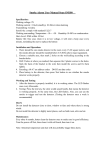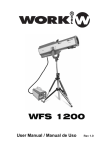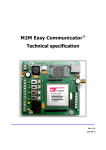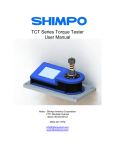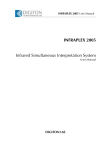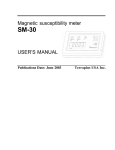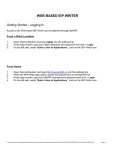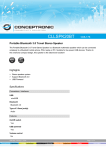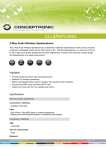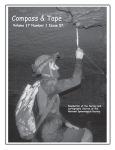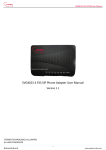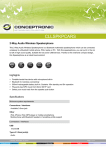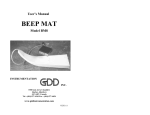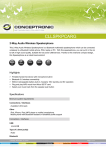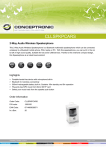Download SM100-User`s manual-face
Transcript
Heritage Group Inc.
Magnetic susceptibility
meter
SM-100
USER’S MANUAL
Publication Date: April 2005
ADDRESS
Heritage Group Inc.
625 Valley Rd.
Littleton, CO 80124
USA
Tel/Fax: 303 - 768-8345
Cell
720 320-2821
E-mail: Jerry@HeritageGeophysics.com
Web: www.HeritageGeophysics.com
1.GENERAL INFORMATION ...................................................... 3
1.1 Application .......................................................................... 3
1.2 Specification........................................................................ 4
2. DESCRIPTION OF INSTRUMENT .......................................... 5
2.1
2.2
2.3
2.4
General description .............................................................. 5
Operating principles ............................................................. 5
Technical implementation of SM-100....................................... 7
Calibration .......................................................................... 9
3 OPERATION........................................................................ 10
3.1
3.2
3.3
3.4
3.5
Switching the instrument ON and OFF ................................... 10
Weighting scale calibration .................................................. 10
Kappa calibration ............................................................... 11
Pot susceptibility compensation............................................ 11
Measuring susceptibility of the rock ...................................... 12
-1-
3.6 Weighting plate.................................................................. 14
4 FIGURES............................................................................. 15
4.1
4.2
4.3
4.4
4.5
Figure
Figure
Figure
Figure
Figure
1 ............................................................................ 15
2 ............................................................................ 16
3 ............................................................................ 17
4 ............................................................................ 18
5 ............................................................................ 19
5.APPENDIX .......................................................................... 20
5.2 SM-100 programme for Windows 9x/NT/2000/XP ................... 20
-2-
1.GENERAL INFORMATION
1.1 Application
Instrument SM-100 is designed to measure magnetic susceptibility of small rock
samples. Due to high sensitivity of the instrument, it is possible to measure
diamagnetic substances as well. The instrument is ready to measure with the
maximum sensitivity within a minute after being set into operation. Advanced
method of signal processing distinctively reduces effects of outer electromagnetic
disturbances and that of circuit noise . The embedded scale (based on
strain-gauge bridge) measures the weight of every sample and the measured
value is used for evaluation of mass susceptibility. The measured values can be
stored on the hard disk or similar medium for later use. Small size and low
weight make it easier to manipulate with the instrument on the working site.
-3-
1.2 Specification
SENSITIVITY……………………1x10-6SI Units for sample 11.147 cubic cm at 320 A/m
(cylinder: d=25.4mm, h=22mm)
DIMENSIONS OF THE PICK-UP UNIT…..……..diameter = 90mm, height = 200mm
WEIGHT:
• pick-up unit…………………………………………………………………………………………..…1.6kg
• accumulator …..…………………………………………………………………………………….…1.1kg
• charger………………………………………………………………………………………………….…0.5kg
• the whole instrument with trasport box…………………………………………………6.1kg
DIMENSIONS OF THE TRANSPORT BOX……………………………………..400x250x170 mm
OPERATING FREQUENCIES………..………….…….…8 kHz, 4 kHz, 2 kHz, 1 kHz, 0.5 kHz
FIELD INTENSITY (effective values)….……….320 A/m, 160 A/m, 80 A/m, 40 A/m,
20 A/m, 10 A/m
MEASUREMENT TIME……………………………………………………………………………. approx. 15s
CONTROLS………………….…weighting sensor in the instrument’s body and by
computer
PICK-UP COIL CAVITY………………………………………………………………. 38 mm in diameter
o
o
OPERATING TEMPERATURE……………………………………………………………..-20 C to +50 C
POWER……………………….………….…….12 VDC / 200 mA, Accumulator and/or charger
TIME BETWEEN CHARGING……………………………………………………..…..typically 10 hours
COMMUNICATION WITH COMPUTER…………………………………………………….………..RS232
-4-
2. DESCRIPTION OF INSTRUMENT
2.1 General description
The susceptibility Meter SM-100 requires a computer with WINDOWS operation
system.
The computer does the processing, displaying and storing of acquired data.
SM-100 is a cylinder-shaped instrument with an opening, through which samples
are put inside the pick-up coil. The measuring process is initialized by placing
a sample into a pick-up unit.
The sample should be removed after an acoustic signal. There are not any control
buttons on the instrument's body. The instrument is switched on automatically
after the activation of the computer application. The instrument can be powered
either by a 12 V accumulator. The accumulator can be charged while the
instrument is in operation.
2.2 Operating principles
The instrument consists of an oscillator, part of which is a pick-up coil. When
a rock sample is placed inside the pick-up coil, it results in a change in oscillator
frequency.
The variation is proportional to the susceptibility of the sample. To be able to
specify the change of the frequency, it is necessary to measure the frequency of
-5-
the oscillator in two steps. First measurement takes place while the rock sample
is inside. This step is further reffered to as "the pick-up step".
Second measurement takes place after the rock sample is removed from the
pick-up coil ("free air measurement"). This step is further reffered to as "the
compensation step". It is the difference in the both frequences that indicates
the value of magnetic susceptibilty. The above mentioned method of
measurement is illustrated in Fig.1
Figure 1a shows the way the oscillator frequency is affected by the measured
sample. It also shows the frequency difference in both the steps. The difference
is used as ground for the calculation of magnetic susceptibility. Figure 1b shows
also the effect of the thermal drift. Susceptibility with unwanted thermal drift is
calculated using the formula
susc + drift = f2 - f1
Because of the strong effect of the thermal drift, this mode of measurement can
be used only for samples with very high suscpetibility.
To suppress the thermal drift the SM-100 employs thermal drift correction mode
described in Fig. 2. Figure 2 makes it possible to derive
susc = (f1 + f3)/2 – f2
-6-
Effect of the drift is eliminated. Note that the above formula is valid only when
the pick-up step is in the center of both compensation steps.
2.3 Technical implementation of SM-100
The SM-100 instrument is controled by computer. The Fig.4 shows „Measuring
control“ window, „Document“ window, „Settings“, „Scale calibration“ and „Kappa
calibration“ windows. The „Document“ window contains table with measured
values and other important data and is placed on the background. This table can
be stored to the XML file (for more details see chapter 5). Fig. 3 describes
technical implementation of SM-100. During the period of time when the
instrument is ready to measure the rock sample, the frequency is continually
being measured at very short successive intervals. The results of the
measurments are transfered to computer and stored in "barrel shift memory".
The oldest measurements are replaced by the latest ones, therefore we have the
information about the time period, which is represented in Fig.3 by t1. There are
a few examples of time samples in Fig.3.
The period of time when the instrumment is ready to measure is represented in
Fig.3 by ready to measure. During this period computer is constantly monitoring
the frequency sample's standard deviations in barrel shift memory. The result of
this is displayed in the status window under a name noise, see Fig.4. Placing of a
rock sample into the instrument is recognised by an weighting sensor inside the
instrument and the numerical value, which is equivalent to "1’st compensation
step", is calculated from the "barrel shift memory" data. The computer
-7-
simultaneously beeps and status window changes color and notice, as shown in
Fig.3a. "1’st sample movement time" is over and " the pick-up step" is initialized.
The end of " the pick-up step" is again signalised by a beep and followed by
a change in color and notice in the status window. Now is the moment for an
operator to remove a sample from the pick-up coil. This is represented in Fig. 3.
by "2’nd sample movement time". After that "2’nd compensation step" follows
automatically.
Susceptibility and weight measuring are processed simultaneously. One of
susceptibilities is displayed in the „Measuring control“ window after finishing the
"2'nd comp. step". The radio buttons are used for changing between Mass and
Volume susceptibilities. If the weight of the sample is to low, the value „N/A“ is
shown instead of value of mass susceptibility. Both susceptibilities and weight of
the sample are stored into the table in „Document“ window on background.
Display of the latest acquired data is accompanied by a double beep. When the
weight of the sample is measured on accurate laboratory balance, it’s value can
be used instead of the value measured by buil-in scale. This is done by entering
this value into the appropriate column in the „Document“ window. The mass
susceptibility is automatically corrected when the value of weight is changed.
The variation in oscillator frequency takes effect for a certain time after
placement or removal of a sample. Placing and removing must be therefore
finished early enough before the beginning of the pick-up step and 2’nd
compensation step, respectively. Time period when a sample must stay in its
place (either inside the coil or far enough from it) is displayed under a name
"settling time" in the status window. For the final result, the data acquired from
-8-
the barrel shift memory for 1’st compensation step are as important as data
acquired during the pick-up step and 2’nd comp. step. To make sure that the
data has not been disturbed (e.g. by movement of metal object within the reach
of the sensor) the noise level in the status window should be checked while
placing in the sample. If necessary, wait until it settles
2.4 Calibration
The calibration of the instrument is made by manufacturer by means of the coil
in the shape of cylindre (d=25.4 mm, h=22 mm). The strength of the field is
calibrated according to voltage induced in the coil. The susceptibility is calibrated
using the same coil loaded with the known impedancy. Each frequency and
strength of the field has its own calibration constant.
The user is allowed to adjust the sensitivity at particular frequencies. It is
possible to do it from the „Kappa Calibration“ window. It is very useful mainly
when the frequency dependence of the magnetic susceptibility is measured.
The calibration constants are stored in two files called:
• cal_fact_SM100_2005_#.xml
• cal_user_SM100_2005_#.xml
where the sign # means the serial number of the instrument which is read from
the instrument. It is not possible to work with the instrument without having the
correct calibration files. Every single instrument has its own calibration files.
-9-
3 Operation
3.1 Switching the instrument ON and OFF
1. Plug the instrument in the accumulator or charger. Connect the instrument
with a computer by the communication cable.
2. Open SM100W application. The instrument switches on automatically. Choose
the number of the communication channel. The table that unfolds itself provides
the information about application versions in both the instrument and computer.
This table disappears after a while.
In case the application versions are not compatible or the connection has not
been established, the table does not disappear.
3. When SM100W application is closed, the instrument is switched off.
Disconnecting of one of the cables switches the instrument off as well.
3.2 Weighting scale calibration
The „Scale calibration“ window can be displayed via menu „Measuring->Scale
calibration“. This window is shown on the Fig. 4. The calibration steps are as
follows:
• insert empty pot into instrument
• press button „Zero“
• remove pot from the instrument
The weight of the pot with minus sign is displayed.
- 10 -
•
The 50g or 100g weight standard is put into the pot. Used value must be
written into the „Calibration value“ edit field.
• Place the pot into the instrument and press „Adjust“ button. The value
behind the label „Scale“ in „measuring control“ window is changed.
• Remove the pot from the instrument and check whether the value behind
• the label „Scale“ is apx. ±0.1g.
Note: The calibration can be repeated if needed.
3.3 Kappa calibration
The SM-100 insatrument is calibrated in factory. Nevertheless the user can
change the sensitivity. After opening the window „Kappa calibration“ via menu
„Measuring->Kappa calibration“ we may change the const. for each measuring
frequency. The measured susceptibility is multiplied by this value. The calibration
const. is also inserted into table in „Document“ window.
3.4 Pot susceptibility compensation
During measuring of samples with very low susceptibility it is recommended to
measure the susceptibility of the empty pot and automaticaly subtract it from the
susceptibility of the measured sample. It is recommended to measure the
susceptibility of the empty pot several times (at least 20times) and calculate the
average value. Then the calculated average value should be inserted into the
column „Pot. Susc.“ of the table in the „Document“ window. Do not forget to put
- 11 -
the value with the sign. (The susceptibility of the pot is usually very low and
negative value.) The subtraction is done automatically by the programme.
3.5 Measuring susceptibility of the rock
1. Switch the instrument on.
2. Chose the measuring frequency and strength of the field in the window
„Settings“, which can be displayed via menu „Measuring->Settings“.
3. The noise level in the status window should be checked before placing in
a sample. If necessary, wait until it settles.
4. Press button „Tara“ in the „Measuring control“ window. Insert the empty pot
and press „Tara“ again. It is not necessary to perform this step during each
measurement. It is sufficient to do it from time to time for suppressing the
thermal drift of the scale. After that the weight of the pot will be automaticaly
subtracted. Remove the pot. The weight of the empty pot is displayed as
a negative value.
5. Insert the pot with sample. The instrument produces a beep. Status window
changes color and notice, as shown in Fig.3. The threshold value of the weight
of the sample for inicialization of this step is 3g. Concerning the sample with
the weight <3g; The information about insertion and removal of the sample
can be supplied to the instrument by pressing hotkeys F5 (insertion) and F6
(removal).These hotkeys must be enabled in the menu „Measuring“ by
deselecting the first menu item „Use weight as a start pulse“. If the weight of
the sample is very small (very near to 0g), the evaluation of the mass
- 12 -
susceptibility is not done and the table column „Mass Susc.“ in the
„Document“ window is filled with the text „N/A“.
6. When the second beep is produced after a short while, the sample should be
removed and placed in a reasonable distance from the coil. Status window
changes color and notice, as shown in Fig.3.
7. Wait until the result is diplayed.
8. If you want to use a different (more accurate) value of the weight, you may
enter it into the table manually and the new mass susceptibility is evaluated.
9. The name and note can be added into appropriate column if needed.
10. The table in the „Document“ window consists of 12 columns. The white
columns are editable, the grey ones are not. If the value in the column „Vol“ is
changed the „Vol. Susc.“ value is automatically changed as well. If the value
in the column „Weight“ is changed, the „Mass susc.“ value is automatically
changed as well. Default value 11148 mm3 is a volume of the cylinder with
dimensions (d=25.4 mm, h=22 mm).
11. It is possible to evaluate the mean value and standard deviation of the group
of measured values. It is simply done by selecting the several values in the
column. The process of selecting values is the same as selecting in usual in
MS Windows. It means that values are selected by left mouse buttone when
the key „shift“ or „ctrl“ are pressed. The result is shown in the rigth corner of
the status bar.
12. It is also possible to select one or more rows to be deleted.
- 13 -
3.6 Weighting plate
The pick-up coil has homogenouse magnetic field in its centre. It means that the
measured value changes very little when the sample is moved. Nevertheless it is
better to place the sample into the centre of the pick-up coil. There are two types
of weighting plates supplied with instrument, see Fig. 5. One plate is for small
samples the second one for bigger samples. The changing of the weighting plates
is very simple. The protective tube is unscrewed from the top of the instrument
and the plate is changed by means of tweezer.
- 14 -
compensating
step
pick-up
step
4 Figures
sample
position
t
4.1 Figure 1
out
a
time
in
value
on the
display
freq. meas
freq. meas
f 1 - average freq.
in pick up step
f 2 - average freq.
in comp. step
freq.
drift
susc.+ drift = f 2
susc.
- f1
f2
b
f1
time
Fig.1
- 15 -
4.2 Figure 2
1'st comp. step
2'nd comp. step
pick-up
step
sample
position
t
t
a
out
time
in
value
on the
display
freq. meas
freq. meas
freq. meas
drift
freq.
susc
drift
b
f1
f2
f3
t
t
Fig.2
- 16 -
time
4.3 Figure 3
Color and text of
the status
window:
green: insert the
sample
blue: remove the
sample
light red: settling
red: mesurement
- 17 -
4.4 Figure 4
- 18 -
4.5 Figure 5
- 19 -
5.APPENDIX
5.2 SM-100 programme for Windows 9x/NT/2000/XP
•
•
•
•
•
•
•
Copy the files:
o sm100w.exe
o sport.dll
o cal_fact_SM100-2005-#.xml
o cal_user_SM100-2005-#.xml
to your hard drive (# means the serial number of the instrument).
Connect the communication cable to a serial port and power cable.
Run SM100W.EXE
Choose serial port where the SM-100 is connected to (COM1, COM2, COM3
or COM4).
Device information window will appear. If there is everything OK, the
window disappears on the other hand, in case of some error, the window
stays as is.
The window named „Measuring control“ is displayed. All important
information about actual measuring are displayed in this window.
note.: If the window is closed it can be displayed again using the menu
item: "View->Show meas. window"
- 20 -
•
•
•
•
In the table (document window) there are columns named: „No“, „Name“,
„Volume“ „Vol. susc.“, „Weight“, „Mass. Susc.“, „Pot susc“, „User cal.“,
„Freq“, „Field“, „noise“ and „Comment“. The white columns are editable.
The grey columns are for information purpose only.
Measured values can be stored into XML file using menu item „File->Save“
or „File->Save As“.
Measured values may be loaded back lately by using menu item
„File->Open“ or processed by third party applications, e.g. MS Excel.
•
In the table (document window) there are columns named: „No“, „Name“,
„Vol. susc.“, „Weight“, „Mass. Susc.“ and „Comment“. Columns „Name“,
„Weight“ and „Comment“ are editable. The columns „Name“ and
„Comment“ are for information purpose only.
•
Measured values can be stored into XML file using menu item „File->Save“
or „File->Save As“.
•
Measured values may be loaded back lately by using menu item
„File->Open“ or processed by third party applications, e.g. MS Excel.
- 21 -
























